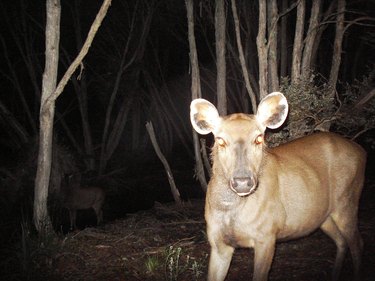
Wildview makes cameras specifically for hunters to track game in the woods. Like other scout or trail cameras, you attach it to a tree or other object, set it and leave it for a few days or weeks. It records animal images on a memory card when its motion sensor detects them moving. You can set it on a tree near a watering hole or stream to calculate the number of animals going there, day or night.
Basics
Video of the Day
To set up the camera, make sure the power switch is off. Insert four "C" batteries. Insert the Secure Digital (SD) card in the slot and set the quality. The camera can take up to 3,328 images on a 2gb SD card in low-quality mode or 1,280 images on the same card in high-quality mode. It also has a 32mb built-in memory that can take 12 images in high quality or 33 images in low quality, according to the manufacturer. The company insists on alkaline batteries, or you can buy the 12V lead acid battery and plug it in for much longer duration shoots.
Video of the Day
Preparation
The first time you set up the Wildview, there are several things you need to do. Some of these you may change as you gain experience with the camera. First, set the time between preset image firing. This is called the "time out" and has options ranging from 1 minute to 20 minutes. Next, determine the quality of the images. Since there images are not generally meant to be kept, you will get more use from lower-quality images because you will get more of them. So, set the resolution to low. Set the flash mode next, based on the lighting conditions in which you intend to shoot. "Auto" will let the camera choose to use the flash based on the light in the area at the time of exposure. "On" means the flash will fire every time the camera does. "Off" will prevent the flash from discharging. You also need to set the "Burst" mode to determine how many images will be shot each time the camera fires. You can choose one of three modes: single shot, double shot or triple shots. You also can choose AVI to allow the camera to take a video image for 10 seconds.
Location
When you have everything set with the camera, the last detail is to place the camera correctly for accurate information. It's a good idea to find a game trail leading to a watering hole or stream. A variety of animals will use the trail to quench their thirst. Don't aim the camera directly at the trail. Get it at about a 45-degree angle to the trail. This will give you the best chance of capturing game images that will, with the time stamp in the camera, allow you to know how many animals are in the area at any particular time, day or night.